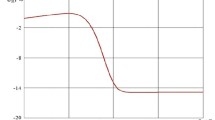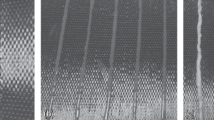Conclusion
The thermal conductivity of organic-glass, organic-carbon, and carbon-glass plastic in dependence on the volumetric content of organic, glass, and carbon fibers was experimentally investigated. The solution for transverse thermal conductivity of unidirectional hybrid composite, obtained in [8] by generalizing the method of self-congruence to the case of a triphase model, is in satisfactory agreement with the experimental data.
Similar content being viewed by others
Literature cited
S. I. Dastin, “Design and concepts of composite structures,” in: Proc. ICCM-3, Paris (1980), pp. 49–68.
V. I. Afanasenko, Yu. A. Afanas'ev, A. G. Glushenko, V. I. Kotlov, I. I. Sokolova, and S. R. Tabaldyev, “Design of the load bearing girder of a space telescope made of hybrid composite material,” Mekh. Kompozitn. Mater., No. 4, 705–714 (1988).
V. F. Zinchenko, “Diagnostics of the porosity of glass reinforced plastics according to their thermal conductivity,” Mekh. Polim., No. 3, 522–525 (1971).
V. F. Zinchenko and S. N. Negreeva, “Investigation of the interrelation between some indices of the structure and physicomechanical properties of organic and carbon reinforced plastics,” in: Methods and Means of the Diagnostics of the Load Bearing Capacity of Products Made of Composites, Riga (1983), pp. 158–165.
A. F. Kregers, I. A. Repelis, and A. M. Tolks, “Thermal conductivity of fibrous composite and of its components,” Mekh. Kompozitn. Mater., No. 4, 604–608 (1987).
L. L. Vasil'ev, G. I. Bobrova, and S. A. Tanaeva, Porous Materials in Cryogenics [in Russian], Minsk (1979).
S. A. Tanaeva, L. S. Domorod, and L. A. Evseeva, “Thermophysical properties of organic fiber materials in the temperature range 5–400 K,” Plast. Massy, No. 6, 30–32 (1984).
V. A. Kochetkov, “Effective characteristics of the elastic and thermophysical properties of unidirectional hybrid composite. Communication 2,” Mekh. Kompozitn. Mater., No. 2, 250–255 (1987).
S. N. Negreeva, “Effect of the structural parameters of hybrid composites on their thermophysical characteristics,” in: Methods and Means of the Diagnostics of the Load Bearing Capacity of Products Made of Composites, Riga (1986), pp. 190–192.
Author information
Authors and Affiliations
Additional information
Translated from Mekhanika Kompozitnykh Materialov, No. 5, pp. 817–822, September–October, 1990.
Rights and permissions
About this article
Cite this article
Kochetkov, V.A. Thermal conductivity of unidirectionally reinforced hybrid composites. Mech Compos Mater 26, 593–597 (1991). https://doi.org/10.1007/BF00616637
Received:
Issue Date:
DOI: https://doi.org/10.1007/BF00616637




